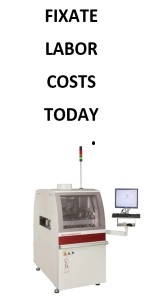Over the last few years, there has been an increase in the use of component parts such as QFNs and power transistors that have large solder paste contact areas underneath the component. Voiding has been found to be drastically increased with these large contact area components compared with typical BGA/CSP components. This has been the result of the larger solder paste volumes applied underneath the part, together with the difficulty of the low boiling point flux gases to escape from under the part during reflow soldering.
Various techniques have been used to reduce the voiding by reducing the amount of solder paste printed under the large contact area component parts as well as reflow profile development. This has reduced the amount of voiding somewhat but the voiding has still been sufficient in some cases to give concerns in terms of thermal heat dissipation and reliability requirements for these soldered components on the board.
This study was done to investigate different flux activator systems that had higher heat resistivity and activation levels even over the melting point of the tin-lead and lead-free solders tested. Test vehicles were assembled using different tin-lead and lead-free solder paste flux formulations with power transistor components on different board surface finishes (OSP, NiAu, Sn, SnAgCu HASL) to assess the amount of voiding present after reflow.






